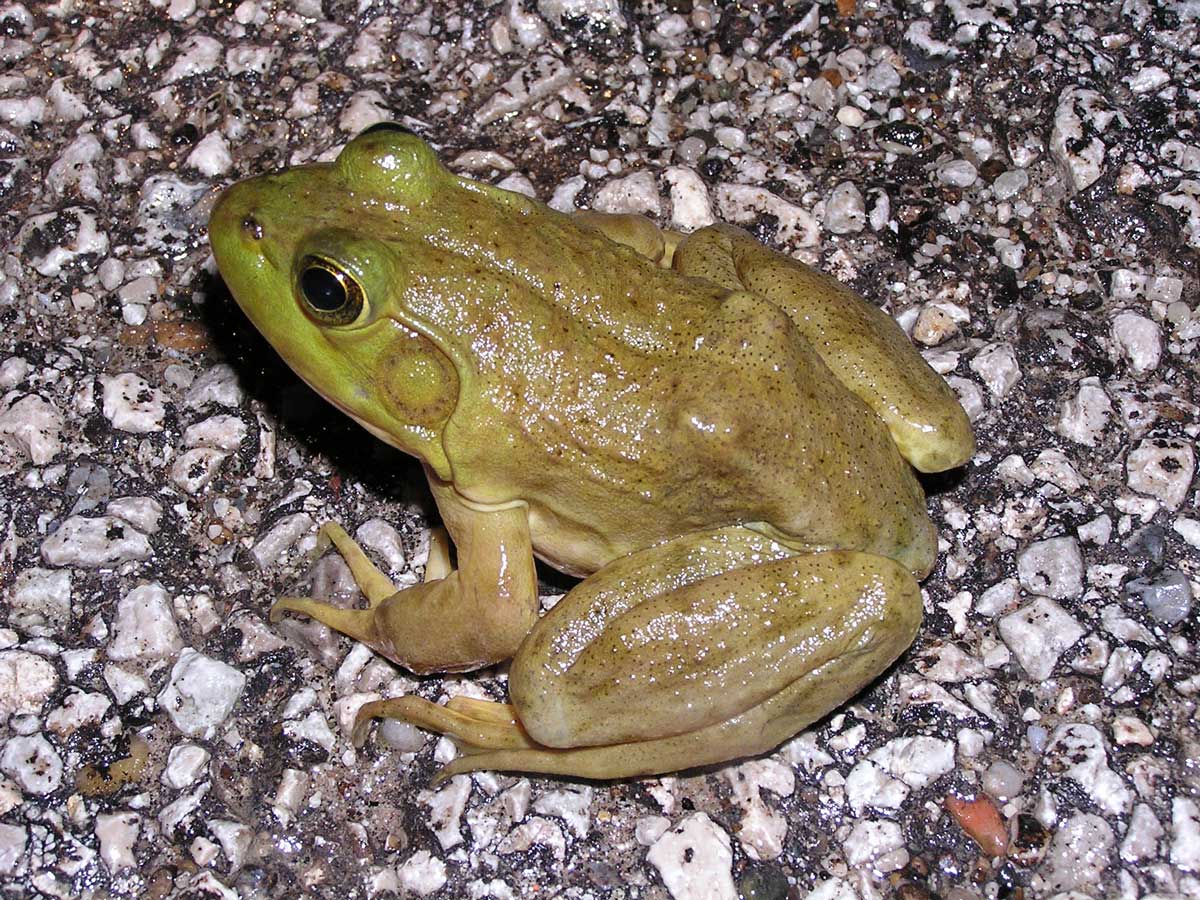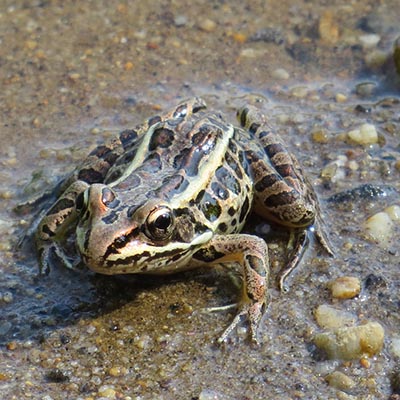Amphibians

American Toad
Anaxyrus americanus
Size: 2-3.5 inches.
Diet: Land-dwelling (terrestrial) invertebrates, including insects and their larvae, spiders, earthworms and millipedes.
Reproduction: Lay up to 2,000 eggs

American Bullfrog
Lithobates catesbeianus
Size: 3.5-6 inches.
Diet: Anything it can swallow, including crayfish, insects, worms and snails.
Reproduction: Eggs are deposited in a surface film containing 10,000 or more eggs.

Cope's Gray Treefrog
Hyla chrysoscelis
Size: 1 ¼ -2 inches.
Diet: Flying insects, insect larvae, spiders, ants, small insects. Forages near lights.
Reproduction: Females may deposit up to 2,000 eggs.

Crawfish Frog
Lithobates areolatus
Size: 2 1/4-4 ½ inches.
Diet: Beetles, spiders, centipedes, ants, and crickets.
Reproduction: Masses of 3,000 - 7,000 eggs attached to vegetation.

Eastern Spadefoot Toad
Scaphiopus holbrookii
Size: 1 ¾-3 ¼ inches.
Diet: Eats invertebrates such as beetles, crickets, caterpillars, spiders and snails.
Reproduction: Deposited in bands or clusters up to a foot long.

Fowler's Toad
Anaxyrus fowleri
Size: 2-3 inches.
Diet: Variety of insects, spiders, worms, centipedes, millipedes, etc.
Reproduction: Strings of 7,000 – 10,000 eggs, attached to vegetation in shallow water.

Green Frog
Hyla cinerea
Size: 2 ¼ - 3 ½ inches.
Diet: Eats aquatic and terrestrial insects and other invertebrates including beetles, flies, butterflies, caterpillars, grasshoppers, spiders, slugs, snails, crayfish, millipedes.
Reproduction Laid in a mass of 1,000-5,000 in a thin film that touches the surface of the water.

Green Salamander
Aneides aeneus
Size: 3-5 inches.
Diet: Beetles, spiders, mites, and ants may be eaten by green salamanders.
Reproduction: Females generally deposit around 15 to 20 eggs by attaching them to the inside wall of a moist rock crevice.

Green Treefrog
Dryophytes cinereus
Size: 1-2 inches.
Diet: Insects.
Reproduction: Found in small packets under the surface of the water, attached to floating vegetation or its roots.

Blanchard Cricket Frog
Acris blanchardi
Size: 5/8-1½ inches.
Diet: Aquatic larvae, insects.
Reproduction: Clusters of 200-400 eggs singly or in small clusters.

Northern Leopard Frog
Lithobates pipiens
Size: 2-3 inches.
Diet: Eats terrestrial invertebrates such as insects and insect larvae, spiders, slugs, snails and earthworms. Large adults also eat other frogs.
Reproduction: Females may deposit 3,000-5,000 eggs in globular clusters.

Pickerel Frog
Lithobates palustris
Size: 1 ¼-3 inches.
Diet: Insects, spiders, worms, and insect larvae.
Reproduction: Globular mass of 700 – 2,900 eggs attached to submerged vegetation.

Plain's Leopard Frog
Lithobates blairi
Size: 2-3 ½ inches.
Diet: Grasshoppers, beetles, crickets, earthworms, snails.
Reproduction: Females may deposit 3,000-5,000 eggs in globular clusters.

Southern Leopard Frog
Lithobates sphenocephalus
Size: 2-3½ inches.
Diet: Insects, earthworms, spiders, centipedes, snails, beetles, and smaller frogs.
Reproduction: Females may deposit 3,000-5,000 eggs in globular clusters.

Western Chorus Frog
Pseudacris triseriata
Size: ¾- 1½ inches.
Diet: Small insects, spiders, small snails, and worms.
Reproduction: Females deposit clumps of up to 300 eggs to sticks and vegetation. Eggs hatch within one week.

Wood Frog
Lithobates sylvaticus
Size: 1 3/8 – 2 ¾ inches.
Diet: Insects, spiders, worms, and snails.
Reproduction: Mass may contain up to 3,000 eggs. Hatch in 2-3 weeks.

